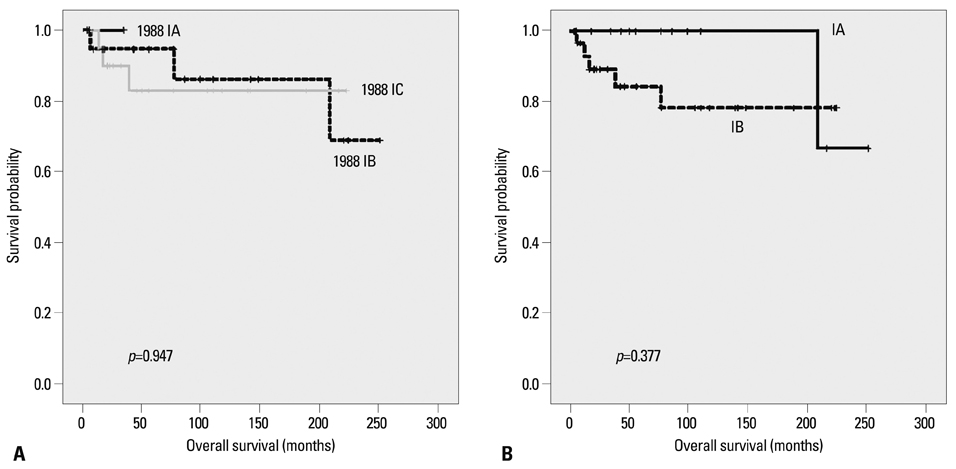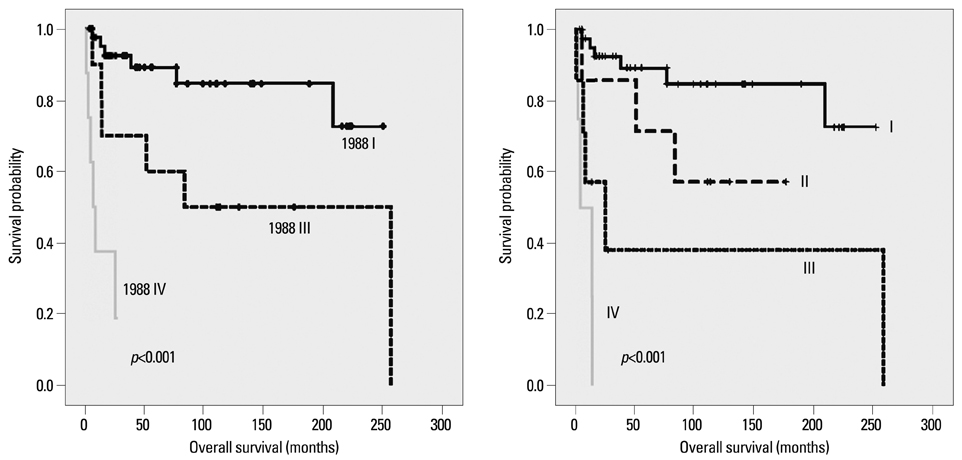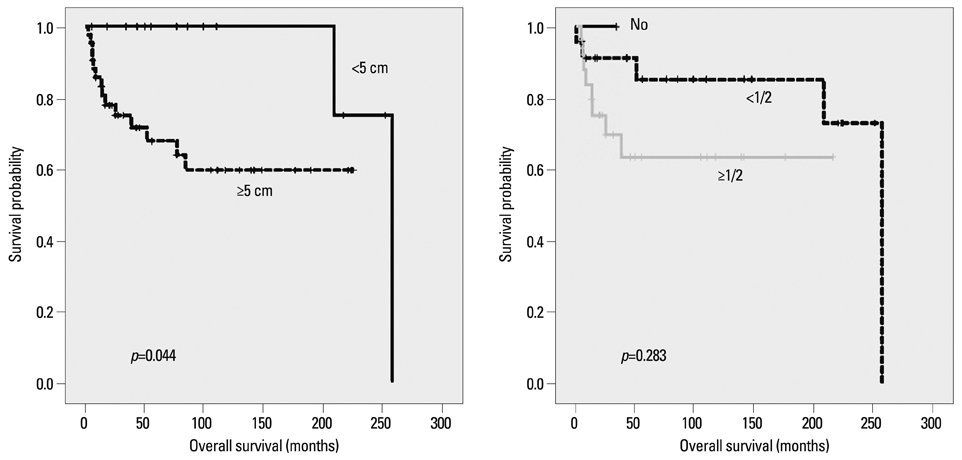Yonsei Med J.
2014 May;55(3):563-569. 10.3349/ymj.2014.55.3.563.
FIGO Staging for Uterine Sarcomas: Can the Revised 2008 Staging System Predict Survival Outcome Better?
- Affiliations
-
- 1Department of Obstetrics and Gynecology, Institute of Women's Medical Life Science, Yonsei University College of Medicine, Seoul, Korea. ytkchoi@yuhs.ac
- KMID: 2068663
- DOI: http://doi.org/10.3349/ymj.2014.55.3.563
Abstract
- PURPOSE
The aim of this study was to compare survival of patients with uterine sarcomas using the 1988 and 2008 International Federation of Gynecologists and Obstetricians (FIGO) staging systems to determine if revised 2008 staging accurately predicts patient survival.
MATERIALS AND METHODS
A total of 83 patients with leiomyosarcoma and endometrial stromal sarcoma treated at Yonsei University Health System between March of 1989 and November of 2009 were reviewed. The prognostic validity of both FIGO staging systems, as well as other factors was analyzed.
RESULTS
Leiomyosarcoma and endometrial stromal sarcoma comprised 47.0% and 53.0% of this study population, respectively. Using the new staging system, 43 (67.2%) of 64 eligible patients were reclassified. Among those 64 patients, 45 (70.3%) patients with limited uterine corpus involvement were divided into stage IA (n=14) and IB (n=31). Univariate analysis demonstrated a significant difference between stages I and II and the other stages in both staging systems (p<0.001) with respect to progression-free survival and overall survival (OS). Age, menopausal status, tumor size, and cell type were significantly associated with OS (p=0.011, p=0.031, p=0.044, p=0.009, respectively). In multivariate analysis, revised FIGO stage greater than III was an independent poor prognostic factor with a hazard ratio of 9.06 [95% confidence interval (CI) 2.49-33.0, p=0.001].
CONCLUSION
The 2008 FIGO staging system is more valid than the previous FIGO staging system for uterine sarcomas with respect to its ability to distinguish early-stage patients from advanced-stage patients.
Keyword
MeSH Terms
Figure
Cited by 1 articles
-
Safety and feasibility of laterally extended endopelvic resection for sarcoma in the female genital tract: a prospective cohort study
Soo Jin Park, Junhwan Kim, Jae-Weon Kim, Hee Seung Kim, Ga Won Yim
Obstet Gynecol Sci. 2022;65(4):355-367. doi: 10.5468/ogs.22071.
Reference
-
1. Major FJ, Blessing JA, Silverberg SG, Morrow CP, Creasman WT, Currie JL, et al. Prognostic factors in early-stage uterine sarcoma. A Gynecologic Oncology Group study. Cancer. 1993; 71:4 Suppl. 1702–1709.
Article2. Abeler VM, Røyne O, Thoresen S, Danielsen HE, Nesland JM, Kristensen GB. Uterine sarcomas in Norway. A histopathological and prognostic survey of a total population from 1970 to 2000 including 419 patients. Histopathology. 2009; 54:355–364.
Article3. Kildal W, Abeler VM, Kristensen GB, Jenstad M, Thoresen SØ, Danielsen HE. The prognostic value of DNA ploidy in a total population of uterine sarcomas. Ann Oncol. 2009; 20:1037–1041.
Article4. Akahira J, Tokunaga H, Toyoshima M, Takano T, Nagase S, Yoshinaga K, et al. Prognoses and prognostic factors of carcinosarcoma, endometrial stromal sarcoma and uterine leiomyosarcoma: a comparison with uterine endometrial adenocarcinoma. Oncology. 2006; 71:333–340.
Article5. Koivisto-Korander R, Butzow R, Koivisto AM, Leminen A. Clinical outcome and prognostic factors in 100 cases of uterine sarcoma: experience in Helsinki University Central Hospital 1990-2001. Gynecol Oncol. 2008; 111:74–81.
Article6. Park JY, Kim DY, Suh DS, Kim JH, Kim YM, Kim YT, et al. Prognostic factors and treatment outcomes of patients with uterine sarcoma: analysis of 127 patients at a single institution, 1989-2007. J Cancer Res Clin Oncol. 2008; 134:1277–1287.
Article7. Kahanpää KV, Wahlström T, Gröhn P, Heinonen E, Nieminen U, Widholm O. Sarcomas of the uterus: a clinicopathologic study of 119 patients. Obstet Gynecol. 1986; 67:417–424.8. Kim WY, Chang SJ, Chang KH, Yoon JH, Kim JH, Kim BG, et al. Uterine leiomyosarcoma: 14-year two-center experience of 31 cases. Cancer Res Treat. 2009; 41:24–28.
Article9. Kim HS, Song YS. International Federation of Gynecology and Obstetrics (FIGO) staging system revised: what should be considered critically for gynecologic cancer? J Gynecol Oncol. 2009; 20:135–136.
Article10. Prat J. FIGO staging for uterine sarcomas. Int J Gynaecol Obstet. 2009; 104:177–178.
Article11. Bodner K, Bodner-Adler B, Obermair A, Windbichler G, Petru E, Mayerhofer S, et al. Prognostic parameters in endometrial stromal sarcoma: a clinicopathologic study in 31 patients. Gynecol Oncol. 2001; 81:160–165.
Article12. Chan JK, Kawar NM, Shin JY, Osann K, Chen LM, Powell CB, et al. Endometrial stromal sarcoma: a population-based analysis. Br J Cancer. 2008; 99:1210–1215.
Article13. Haberal A, Kayikçioğlu F, Boran N, Calişkan E, Ozgül N, Köse MF. Endometrial stromal sarcoma of the uterus: analysis of 25 patients. Eur J Obstet Gynecol Reprod Biol. 2003; 109:209–213.
Article14. Chang KL, Crabtree GS, Lim-Tan SK, Kempson RL, Hendrickson MR. Primary uterine endometrial stromal neoplasms. A clinicopathologic study of 117 cases. Am J Surg Pathol. 1990; 14:415–438.15. Evans HL. Endometrial stromal sarcoma and poorly differentiated endometrial sarcoma. Cancer. 1982; 50:2170–2182.
Article16. Amant F, Vergote I, Moerman P. The classification of a uterine sarcoma as 'high-grade endometrial stromal sarcoma' should be abandoned. Gynecol Oncol. 2004; 95:412–413.
Article17. Giuntoli RL 2nd, Metzinger DS, DiMarco CS, Cha SS, Sloan JA, Keeney GL, et al. Retrospective review of 208 patients with leiomyosarcoma of the uterus: prognostic indicators, surgical management, and adjuvant therapy. Gynecol Oncol. 2003; 89:460–469.
Article18. Kapp DS, Shin JY, Chan JK. Prognostic factors and survival in 1396 patients with uterine leiomyosarcomas: emphasis on impact of lymphadenectomy and oophorectomy. Cancer. 2008; 112:820–830.
Article
- Full Text Links
- Actions
-
Cited
- CITED
-
- Close
- Share
- Similar articles
-
- Revised International Federation of Gynecology and Obstetrics (FIGO) staging systems in gynecologic malignancies
- Revised FIGO Staging System
- Uterine Cervical Cancer: Emphasis on Revised FIGO Staging 2018 and MRI
- MR Imaging for Staging of Cervical Carcinoma: Update
- Prognostic significance of tumor laterality in advanced ovarian cancer




